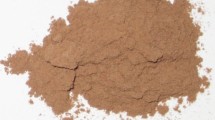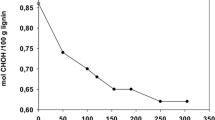Abstract
Phenol-tannin-formaldehyde resins prepared by copolymerization of resoles andPinus pinaster bark tannins were used for bonding eucalyptus plywood boards. The dependence of board quality on the formaldehyde/phenol ratio F/P, the overall soda/phenol ratio S/P and the viscosity of the resol was studied using a 2×2×2 factorial design. The most critical of the variables studied was S/P, the best results being obtained with its lower value. A follow-up study using a lower S/P value confirmed this trend, better results being obtained than with commercial phenolic resins. Moreover, the pine-based resins allowed a press temperature of 160°C to be used, which further improved board quality.
Zusammenfassung
Phenol/Formaldehyd-Harze wurden durch Copolymerisation von Resolen mit Rindentannin ausPinus pinaster hergestellt und zum Verleimen von Sperrholzplatten verwendet. Die Abhängigkeit der Sperrholzqualität vom Formaldehyd/Phenol-Verhältnis (F/P), vom Soda/Phenol-Verhältnis (S/P) und von der Viskosität der Resole wurde untersucht. Als kritischste Variable erwies sich das S/P-Verhältnis, wobei die besten Ergebnisse mit geringeren S/P-Werten erzielt wurden. Eine nachfolgende Untersuchung, bei der niedrige S/P-Verhältnisse eingesetzt wurden, bestätigte diese Tendenz. Die Ergebnisse übertrafen die Werte, die unter Verwendung kommerzieller Phenolharze gewonnen wurden. Zudem ermöglichten die aus Kiefernrinde hergestellten Harze eine Preßtemperatur von 160° C, was zu einer weiteren Verbesserung der Sperrholzqualität führt.
Similar content being viewed by others
References
Box, G. E. P.; Hunter, W. G.; Hunter, J. S.: Statistics for Experimenters: An introduction to design, data analysis and model building. Wiley 1978
Lambuth, A. L.: Adhesives from renewable resources: Historical perspective and wood industry needs. In: Adhesives from renewable resources. Hemingway, R. W.; Conner, A. H. Eds. A. C. S. Symp. Series No 385 (1989) 1–10
Pizzi, A.: Wood adhesives. Chemistry and technology. Marcel Dekker 1983
Vázquez, G.; Antorrena, G.; Parajó, J. C.: Studies on the utilization of Pinus pinaster bark. Part 1: Chemical constituents. Wood Sci. Technol. 21 (1987) 65–74
Vázquez, G.; Antorrena, G.; Parajó, J. C.; Francisco, J. L.: Preparation of wood adhesives by polycondensation of phenolic acids from Pinus pinaster bark with resoles. Holz Roh-Werkstoff. 47 (1989) 491–494
Vázquez, G.; Antorrena, G.; Francisco, J. L.; Conzález, J.: Properties of phenolic-tannin adhesives from Pinus pinaster bark extracts as related to bond quality in Eucalyptus plywoods. Holz Roh-Werkstoff 50 (1992) 253–256
Author information
Authors and Affiliations
Additional information
This study was subsidised by the Xunta de Galicia. The authors wish to express their gratitude to FORESA for technical assistance.
Rights and permissions
About this article
Cite this article
Vázquez, G., Antorrena, G., Francisco, J.L. et al. Exterior plywood resins formulated from Pinus pinaster bark extracts. Holz als Roh-und Werkstoff 51, 221–224 (1993). https://doi.org/10.1007/BF02628284
Issue Date:
DOI: https://doi.org/10.1007/BF02628284




